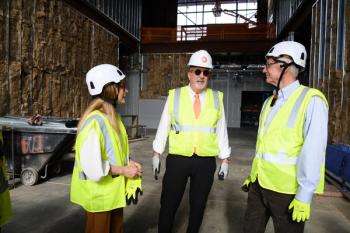
What veterinarians can learn from plumbers
We can learn a lot from plumbers when it comes to charging for our services
Dr. Janice Johnson looked at the toilet. It looked fine to her. She looked again and flushed it. When the initial torrent faded away, she heard it: a faint hiss in the tank.
She pulled the lid off and peered inside. Could this be the source of her water bill explosion? She closed the lid and picked up her water bill that was now clad in a smattering of water. Looking carefully, she thought she could finally decipher the hieroglyphically encoded implication — she owed a lot more money than she usually owed. Monthly water consumption at the clinic over the past 60 days had been five times higher than previous months.
The next morning she arrived at the clinic early to a stack of bills and the usual client exasperations over this and that from the day before. It took her 45 minutes to get through the morass of notes and phone calls and finally be able to see her patients.
Dr. Johnson loved her work and loved her patients. This morning there was a diabetic cat waiting in a cage for a blood draw. Below her was a small rat terrier scheduled to be spayed later in the morning. Her name was Juanita.
Jill Prescott, a veterinary assistant, came briskly into the room. "Hey, Dr. Johnson, there's a hissing sound coming from the bathroom toilet. It's been there for several weeks. Has anyone told you?"
"No one told me anything," she said, sarcastically.
Jill nodded sheepishly. "Do you think it's a problem?"
"I don't know," Dr. Johnson said, "but I'll call the plumber this morning and have it checked out."
Later that morning, Dr. Johnson called Acme Plumbing. As she did, she noticed a payroll printout her bookkeeper had left for her. "Criminy," she muttered to herself. "I'd like to pay people more, but I'm barely making payroll as it is."
Later that afternoon, Jimmy Smithson from Acme Plumbing arrived. He was fresh-faced and bowlegged and talked out of the side of his mouth in a western style. It was easy to tell he spent his leisure time around horses.
Jimmy spent a few minutes in the bathroom, then caught Dr. Johnson on her way out of an exam room. "Hey, doc," he said, "you've probably been losing a lot of water around your toilet flapper. Your wax ring is leaking, too."
"Can you fix it?" Dr. Johnson asked.
"Sure can," Jimmy replied, "and the parts are cheap. I can go to Wal-Mart and pick 'em up. I'll be back here in a jiffy."
Jimmy was back again in about an hour. In another 30 minutes, he'd fix both problems.
He presented a bill and said, "That wax ring was a bugger!"
Dr. Johnson took a look: $33.03 for parts — the same as the stapled receipt — and $414 for labor and a trip fee. She was stunned.
"How–how much was the trip charge?" she stammered.
"Well, usually $100, but I charged you $80 because you were just around the corner. I still had to charge you for gas for going to Wal-Mart."
"Did you charge labor for the time you spent in Wal-Mart?" she queried.
He looked surprised. "Boss man says we're on the clock the minute we leave the plumbing office."
Dr. Johnson marched into the office and peeked at her bank balance. She pulled out the checkbook and wrote a check for $447.03. She marched back and gave it the budding plumber.
"Much obliged," he said. "Can I ask you a question?"
Dr. Johnson was internally miffed but outwardly congenial. She waited for the inevitable.
"Do you treat any horses?" he asked.
She sighed. "Well, I used to but couldn't make a go of it really. The small animals just took over," she said, mostly to the wall.
"Well, my dad runs a lot of horses, and when he found out I was comin' here, he asked me to ask you ... "
He paused.
"And?"
"He wants to know if you can order him a bunch of horse wormer and give him a good bulk price."
She sighed. "I'll think about it," she said.
(If you guessed that this story is true and loosely autobiographical, go to the head of the class.)
The plumber's solution
Plumbers are ahead of the game. They learned years ago that to stay in business they needed to charge appropriately for people (labor). When big discount stores started undercutting plumbers' prices for supplies and material sales, plumbers modified their old sales model of hiding the true legitimate labor costs with a big markup on supplies.
These days, plumbers charge an equal or nominally increased fee for materials and unashamedly charge whatever the market will bear for the plumbing job itself. After all, few people are adequate do-it-yourself plumbers. The plumbers' response to the discount store incursion into their profession was this: Charge a lot more for labor.
Is plumbing really a commodity? No, it's not. It's a professional service only a few trained professionals do competently.
The veterinarian's dilemma
On the other hand, let's consider veterinary medicine. Although some consumers view it as a commodity (see "The 4-3-2-1 client countdown" on page 32 for more), veterinary care is a licensed service few can do that requires years of training and education. For years, veterinarians have charged for services the way plumbers did in the old days. That is, labor costs have been buried in charges for materials (vaccinations, medications, food).
Now to be fair, some significant income is derived from labor: exams, consultations and surgical fees. These fees roughly cover the base cost for paying professional veterinarians if these fees are high enough. What fees cover the payroll costs for the rest of the staff? Well, none, except for the markup on materials.
In recent years, pet medications and other pet products have become easily available through the Internet. Unlike plumbers, however, most veterinarians have just watched their sales of materials dwindle away with little response or plan for action.
If we truly believe that veterinary healthcare is a service and not a commodity, then my question for our profession is: Are we finally willing to step up to the plate and charge adequately for people and charge nominally for materials?
Charging nominally for materials
A large markup on materials — sometimes 200 percent or more on items — has been the standard for years. Now remember, even with these markups, many veterinarians have trouble paying their bills.
Why? Because we're using material sales to offset labor costs. Once you understand that, you have only one choice if you want to continue to sell in this competitive environment: Lower your margin on materials and find other ways to charge for staff costs. That's the plumber's answer. That solution is a long-term proposition because sales won't instantly pick up to offset revenue. Therefore, and it is a big therefore, you must take the plunge.
The plunge
People fees must be evaluated based on the needs of your business, not on your competitive environment. If your staff costs are 25 percent of your overall expenses, then new and increased fees on the people side will need to offset your losses from material markup.
Here are some new codes and fees to consider. This list is by no means all-inclusive:
New codes
> Technician time
> Staff time: Assistant
> Staff time: Radiology
> Surgical nursing
New ideas
> Charge for time spent with clients outside of normal hours, not just emergency fees.
> Charge exam-room consultations fees that reflect the time spent consulting, not a boilerplate flat rate.
> Charge additional doctor-care fees during the day beyond the hospitalization fee.
> Charge for time spent by veterinarians on behalf of the patient outside of the exam room (the lawyer's solution).
Conclusion
Veterinary medicine will fail the next generation if we don't change our fee structures. That cannot be done with a gigantic markup on materials. It's time to charge for what we do, not what we sell.
Dr. Lane is a graduate of the University of Illinois. He owns and manages two practices in southern Illinois. Lane completed a master's degree in agricultural economics in 1996. He is a speaker and author of numerous practice-management articles. He also offers a broad range of consulting services. Dr. Lane can be reached at
For a complete list of articles by Dr. Lane, visit
THE 4-3-2-1 CLIENT COUNTDOWN
Go online to
Newsletter
From exam room tips to practice management insights, get trusted veterinary news delivered straight to your inbox—subscribe to dvm360.




